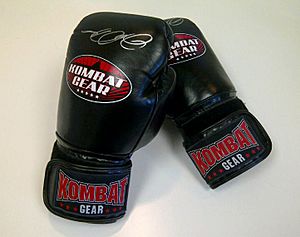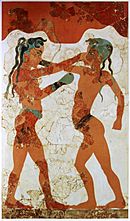Boxing glove facts for kids
Boxing gloves are soft, padded gloves that fighters wear on their hands. They are used during boxing matches and practice sessions. Unlike older, harder hand coverings, modern boxing gloves are designed to protect both the boxer's hands and their opponent's head. This makes the sport safer for everyone involved. Different types of gloves are used for sparring and other kinds of boxing training.
Contents
History of Boxing Gloves
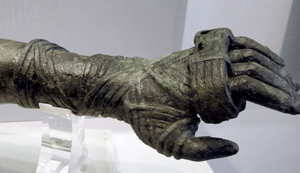
People have used hand protection in fighting sports for a very long time. Pictures from the Middle East and Egypt around 2000 BC show boxers with wrist bands. The earliest images of gloves in boxing come from Minoan Crete around 1500 BC.
In Ancient Greece, fighters often wrapped leather strips around their hands. This offered some protection. Later, in Roman times, these wraps became the "cestus." The cestus often had metal added to it, making fights much more dangerous. The oldest actual boxing gloves found are from about AD 120. They are two leather bands found at a Roman fort called Vindolanda. Boxing became so brutal that it was banned in AD 393.
Boxing became popular again in Britain around the 1600s. Many fights were done with bare knuckles (no gloves). There were no standard rules until Jack Broughton created "Broughton's Law" in the 1700s. At this time, gloves were only used for practice.
However, many boxers still fought without gloves until 1867. That's when the Marquess of Queensberry Rules made gloves a must-have for fights.
Modern boxing gloves began to appear in the late 1890s. Over the years, engineers and boxing companies have worked hard. They have made gloves safer and more durable. Today's gloves often have mesh palms, velcro straps, and special padding. The International Boxing Association checks and approves new glove designs. They make sure gloves follow rules about weight, padding, and support.
Features of Boxing Gloves
Boxing gloves usually have either laces or velcro straps.
- Velcro gloves are easy to put on and take off. The velcro helps support your wrist, like a second hand wrap.
- Lace-up gloves fit more snugly and securely. But you usually need someone else to help you tie them. They are often taped up before a match. You can even change lace-up gloves into velcro ones using a special converter.
Gloves are usually filled with one of these types of padding:
- Foam padding uses materials like latex and PVC foam. These foams are good at absorbing shocks.
- Horsehair padding gloves last longer and are more natural. However, they offer a bit less protection than foam gloves.
- Some gloves use a mix of both foam and horsehair.
In amateur boxing, gloves must be red or blue. They often have a white "scoring area" on the knuckles. This helps judges see when a punch lands correctly and score points.
Boxers wear hand wraps under their gloves. These wraps are usually made of cotton. They help keep the hand and wrist stable. This prevents injuries like a boxer's fracture, which is a break in a bone in the hand. Hand wraps come in different lengths, like 120 inches (3,000 mm) or 170 inches (4,300 mm).
Types of Boxing Gloves
| Type | Images | Description | Available size |
|---|---|---|---|
| Bag gloves | 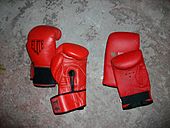 |
These gloves protect your hands when you hit punching bags. Some trainers do not recommend them for all boxing training. | 8 oz 10 oz 12 oz 14 oz 16 oz |
| Bag mitts | Mitts offer light protection for your hands when hitting punching bags. They help strengthen your hands and practice proper punching. | 2oz | |
| Sparring gloves | 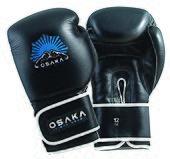 |
These gloves are made to protect both boxers during practice fights (sparring). They are usually heavier than competition gloves. This helps prevent injuries during training. | 4 oz 6 oz 10 oz 12 oz 14 oz 16 oz 18 oz 20 oz |
| Competition gloves |  |
These gloves are used in official boxing matches. They are designed to protect both fighters and follow specific rules. They usually have less padding than sparring gloves. | 8 oz
10 oz 12 oz |
| Lace Up gloves | 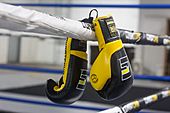 |
Professional boxers often use these gloves for both training and competitions. | 8 oz
10 oz 12 oz 14 oz 16 oz |
Safety in Boxing
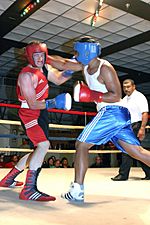
Boxing gloves are very important for safety in boxing. In the past, when boxers fought with bare knuckles, they often avoided hitting the head. This was because they could easily hurt their own hands. Gloves help reduce cuts and protect a boxer's hands.
However, even with gloves, head injuries can still happen. This is because the main cause of head injury is the head moving very quickly back and forth. Gloves allow fighters to punch harder, which can increase this movement. Gloves can help reduce eye injuries, but serious eye problems can still occur.
Bare-knuckle boxing was much more dangerous than modern boxing. Fights often lasted for hours until one fighter could not continue. The rules were also different, sometimes allowing grappling and throws. This meant fighters could hit their heads on hard surfaces. Today, gloves are a must for safety in both professional and amateur boxing.
Weighted Training Gloves
Some boxers use weighted training gloves. These gloves are heavier, usually between one and three kilograms. They add resistance to punching exercises. Using them can help a boxer gain strength over time. This can make their punches faster and more powerful. Boxers often switch between weighted gloves and regular gloves. This helps them build strength without changing their normal punching style. Light dumbbells are sometimes used in a similar way.
Influence of Boxing Gloves in Other Fight Sports
You might see other types of gloves in different fight sports. For example, mixed martial arts (MMA) uses "open-fingered" or "grappling" gloves. These are not boxing gloves. They have some padding but leave the fingers and palm open. This allows fighters to do wrestling and grappling moves, which are not allowed in modern boxing. These gloves are similar to the "kempo gloves" made popular by Bruce Lee in his movie Enter the Dragon.
|
See also
 In Spanish: Guantes de boxeo para niños
In Spanish: Guantes de boxeo para niños
- Headgear (martial arts)
- MMA gloves


